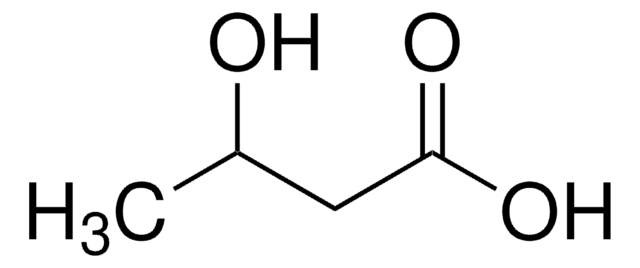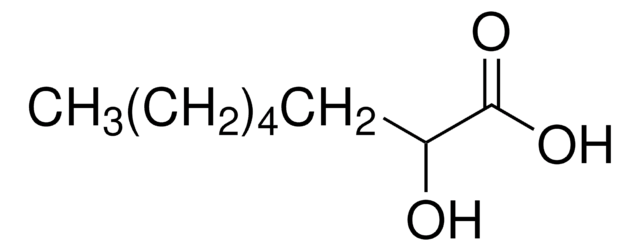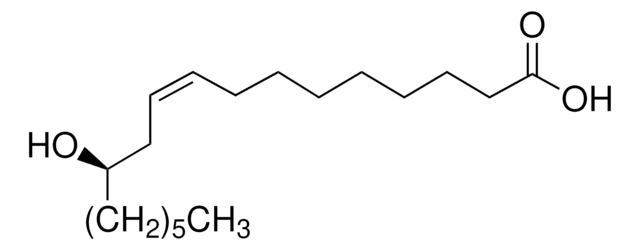H4148
DL-β-Hydroxymyristic acid
≥98%
Synonym(s):
3-Hydroxytetradecanoic acid
Sign Into View Organizational & Contract Pricing
All Photos(1)
About This Item
Empirical Formula (Hill Notation):
C14H28O3
CAS Number:
Molecular Weight:
244.37
MDL number:
UNSPSC Code:
12352211
PubChem Substance ID:
NACRES:
NA.25
Recommended Products
biological source
synthetic (organic)
Quality Level
Assay
≥98%
form
powder
functional group
carboxylic acid
lipid type
saturated FAs
shipped in
ambient
storage temp.
2-8°C
SMILES string
CCCCCCCCCCCC(O)CC(O)=O
InChI
1S/C14H28O3/c1-2-3-4-5-6-7-8-9-10-11-13(15)12-14(16)17/h13,15H,2-12H2,1H3,(H,16,17)
InChI key
ATRNZOYKSNPPBF-UHFFFAOYSA-N
Biochem/physiol Actions
DL-β-Hydroxymyristic acid (3-HTA) is a mixture of D- and L-β-hydroxymyristic acid enantiomers. 3-Hydroxytetradecanoic acids are used to study their roles in biological processes such as oxidative stress, inflammation and insulin resistance. 3-HTA is also used in endotoxin and lipid A research.
Storage Class Code
11 - Combustible Solids
WGK
WGK 3
Flash Point(F)
Not applicable
Flash Point(C)
Not applicable
Personal Protective Equipment
dust mask type N95 (US), Eyeshields, Gloves
Choose from one of the most recent versions:
Already Own This Product?
Find documentation for the products that you have recently purchased in the Document Library.
Customers Also Viewed
K Tanamoto
Advances in experimental medicine and biology, 256, 203-213 (1990-01-01)
New quantitative method for the detection of minute amounts of endotoxin has been developed using 3-hydroxytetradecanoic acid as a chemical marker. After converting 3-hydroxytetradecanoic acid to methyl ester, it was coupled with a fluorescent probe, anthracene-9-carboxyl chloride, obtained by chlorization
Pauline Grimm et al.
The British journal of nutrition, 123(4), 372-382 (2019-11-07)
Starchy diets can induce hindgut dysbiosis in horses. The present study evaluated the impact of a yeast (Saccharomyces cerevisiae) and microalgae (Aurantiochytrium limacinum) supplementation on caecal, colonic and faecal microbial ecosystem and on blood inflammatory parameters of horses fed high-fibre
Wenkuan Liu et al.
Applied microbiology and biotechnology, 76(5), 1153-1159 (2007-08-02)
Medium-chain-length polyhydroxyalkanoates (mcl-PHA) consisting of 3-hydroxyhexanoate (HHx), 3-hydroxyoctanoate (HO), 3-hydroxydecanoate, 3-hydroxydodecanoate, and high-content 3-hydroxytetradecanoate (HTD) was produced by knockout mutant Pseudomonas putida KT2442 termed P. putida KTOY06. When grown on 6 to14 g/L single-carbon-source tetradecanoic acid, P. putida KTOY06, which
A S Soydan et al.
Mediators of inflammation, 2006(5), 64980-64980 (2007-03-30)
Beta-hydroxy fatty acids are a major component of lipid A moiety of lipopolysaccharide. We aimed to investigate the role of free beta-hydroxy fatty acids on inflammation, as well as to evaluate their effects on cytokine release from human blood cells
Anelise M Tonin et al.
Neurochemistry international, 56(8), 930-936 (2010-04-13)
Accumulation of long-chain 3-hydroxy fatty acids is the biochemical hallmark of long-chain 3-hydroxyacyl-CoA dehydrogenase (LCHAD) and mitochondrial trifunctional protein (MTP) deficiencies. These disorders are clinically characterized by neurological symptoms, such as convulsions and lethargy, as well as by cardiomyopathy and
Our team of scientists has experience in all areas of research including Life Science, Material Science, Chemical Synthesis, Chromatography, Analytical and many others.
Contact Technical Service












